Fluidized bed solutions for optimized ingredient production
With populations aging in virtually every nation across the globe, consumer demand for solutions that can tackle age-related conditions such as sarcopenia and keep people active for longer is growing at an impressive rate. The industrial-scale production of innovative food ingredients requires state-of-the-art technologies. Fluidized bed processes offer manufacturers almost unlimited possibilities in terms of optimized particle design and the functionalization of ingredients.
- Author: Dr. Michael Jacob, Head of Process Technology Food, Feed & Fine Chemicals, Glatt Ingenieurtechnik GmbH
- originally published in the trade magazine ‘NutraCos’, issue 03/2016, B5 S.r.l.
Functional foods have become an established market segment. Their increasing complexity is putting greater demands on established production processes, which means that manufacturers are faced with the challenge of ensuring ingredient stability throughout the entire shelf-life of the product, for example. Furthermore, the taste of many ingredients needs to be optimized, their release profiles must be carefully controlled and they must dissolve easily in water. Moreover, micro-components such as vitamins, minerals or probiotics cannot be incorporated into foodstuffs in their natural state; they have to be coated or encapsulated. To ensure that ingredients possess the required functionalities for successful formulation, fluidized bed technology can play a key role in adjusting product attributes to achieve optimal results.
Gentle drying of sensitive ingredients
A fluidized bed is formed when a quantity of a solid particulate substance, usually present in a holding vessel, is placed under appropriate conditions to cause a solid/fluid mixture to behave as a fluid. This is usually achieved by the introduction of a process gas stream through the particulate medium. Also used to bulk dry a variety of materials, fluidized bed technology makes the process more efficient by suspending the material to be dried and exposing its entire surface to the air. A distribution plate ensures that the current of air has defined flow characteristics, which assists with the mixing process and creates the fluid bed.
Because the drying temperature is independent of the drying time and uniform across the process chamber, the process is relatively gentle and helps to preserve the functional and nutritional properties of the ingredients. As a rule in food applications, the products are typically subjected to a moderate heat (30–50 °C), meaning that temperature-sensitive ingredients such as enzymes, proteins, flavourings, vitamins and micro-organisms can also be treated. Plus, beyond the thermal treatment of solid materials, fluidized bed technology can be used to produce granules from powders or liquids and/or to coat and encapsulate particles as well.
The selection and combination of the right process parameters depends on the required product properties: How fast, if at all, should the product dissolve? When should the flavour or active ingredient be released? What role does bulk density play in terms of application, handling, storage and packaging, and how stable do the particles need to be?
Glatt, an engineering service provider, knows how to tackle these issues. The company plans, develops and distributes fluidized bed systems for the food, feed and chemical industries. Glatt’s technology enables manufacturers to optimize the properties of a wide range of products: from readily soluble drink powders comprising semi-hydrophobic components to dust-free agglomerated baby foods.
Dust-free and homogenous products
With the help of spray granulation, it is possible to dry liquid food additives — such as stabilisers, flavours or sweeteners — while precisely adjusting their particle size, residual moisture levels and solids content, resulting in round pellets with excellent physical properties. The outcome is a free-flowing granulate that is virtually dust-free and very easy to dose. Spray granulation is particularly suitable for dry food additives and encapsulated ingredients.
Agglomeration for readily soluble instantized powders
Like spray granulation, agglomeration makes the product easier to handle. Using fluidized bed technology, poorly soluble powders can be transformed into agglomerates that dissolve much more readily in water — instant cocoa powder and cappuccino drinks, for example. During the agglomeration process, fine powder particles are stuck together with a liquid to form blackberry-like structures. Wetting the surface of these particles and subsequent drying causes the powder particles to adhere to each other and form free-flowing porous agglomerates. As such, it is possible to make dust-reduced, easy to portion powders for drink dispensers and readily dispersible dried milk. Moreover, agglomeration prevents the individual constituents from separating when processed.
Functional surfaces or protective films
For manufacturers of nutritional supplements, protecting their valuable active ingredients is vitally important. A functional film coating not only provides a smooth layer that makes capsules easy to swallow, it also offers a protective barrier against oxygen, light and moisture. Moreover, coatings can mask the sometimes undesirable tastes associated with certain ingredients. Vitamin and mineral mixtures often have a metallic or astringent taste if mineral salts are used.
Coatings can also improve the release characteristics of active ingredients. A functional surface layer can be created that, depending on the pH, either partially or completely dissolves, offering “slow”, “targeted” or “controlled” release mechanisms for specific ingredients. When used in food production, for instance, the release of citric or lactic acid during the maturation of sausages can be controlled by coatings.
Resistant to external influences: microcapsules
Probiotic foods represent another application opportunity for the sustained release of active ingredients. Only if the probiotic microorganisms reach the small intestine alive will they have a chance to multiply and positively affect the intestinal flora. This means that they have to pass safely through the stomach. And probiotics that are destined to reach the colon also have to be protected against bile acids and digestive enzymes in the small intestine.
To successfully transport probiotic cultures into the intestinal tract, they are added to foods in the form of microcapsules that open or dissolve in a pH-dependent manner. For other nutraceutical applications, functional ingredients can be microencapsulated into a free-flowing powder or granulate that’s coated with a millimetre- or even micrometre-thick layer of polymers, starch derivatives, lecithin or gelatine, for example, making them resistant to external influences.
Tailor-made solutions
Thanks to its comprehensive technology expertise, Glatt is able to offer solutions for demanding or complex applications that require precisely defined shape or solubility characteristics, homogenous particle sizes or the functional protection of active ingredients. Glatt offers laboratory units and pilot plants for early stage trials and testing, which are available both at the company’s technology centre as well as for use in the client’s own laboratories. And, based on its extensive consulting experience — from planning and construction to the implementation of tailor-made production plants — Glatt also offers comprehensive engineering services as well as entire turn-key solutions.
Taking an individual approach to each project, Glatt designs, develops and delivers plants that are customized to meet specific customer requirements. Process technologies are initially assessed in small-scale laboratory units (1-2 kg). Then, based on demand and the formulation, the company determines the optimal operational parameters in pilot studies, facilitating reliable scale-up.
Volker Budzinski, Sales Manager Process Technology Food, Feed & Fine Chemicals, comments: “We don’t offer standardized, off-the-shelf production equipment. Our clients approach us with many different questions and requirements. Together, we develop the most suitable technological strategy. Primarily, we are solution providers. We develop and optimize processes for various applications, and also design the appropriate individual plant or even entire production lines that are ready to use. Whatever the project, we accompany our clients from initial start-up to conclusion.”
Further information on this topic and related topics can also be found in the following publications:
Published article: ‘Spray agglomerating plant-based milk alternatives for optimised product properties’ PDF, English
Published article: ‘The gentle processing of highly volatile oils by fluid bed and spouted bed technology’ PDF, English
Published article: ‘Process Technologies to Optimize Detergent Manufacturing’. PDF, English
Published article: ‘Spray (micro)encapsulation of sensitive substances in matrix form – An overview of essential oil and vitamin case studies’ PDF, English
Published article: ‘Improved performance for crop protection products’, PDF, English

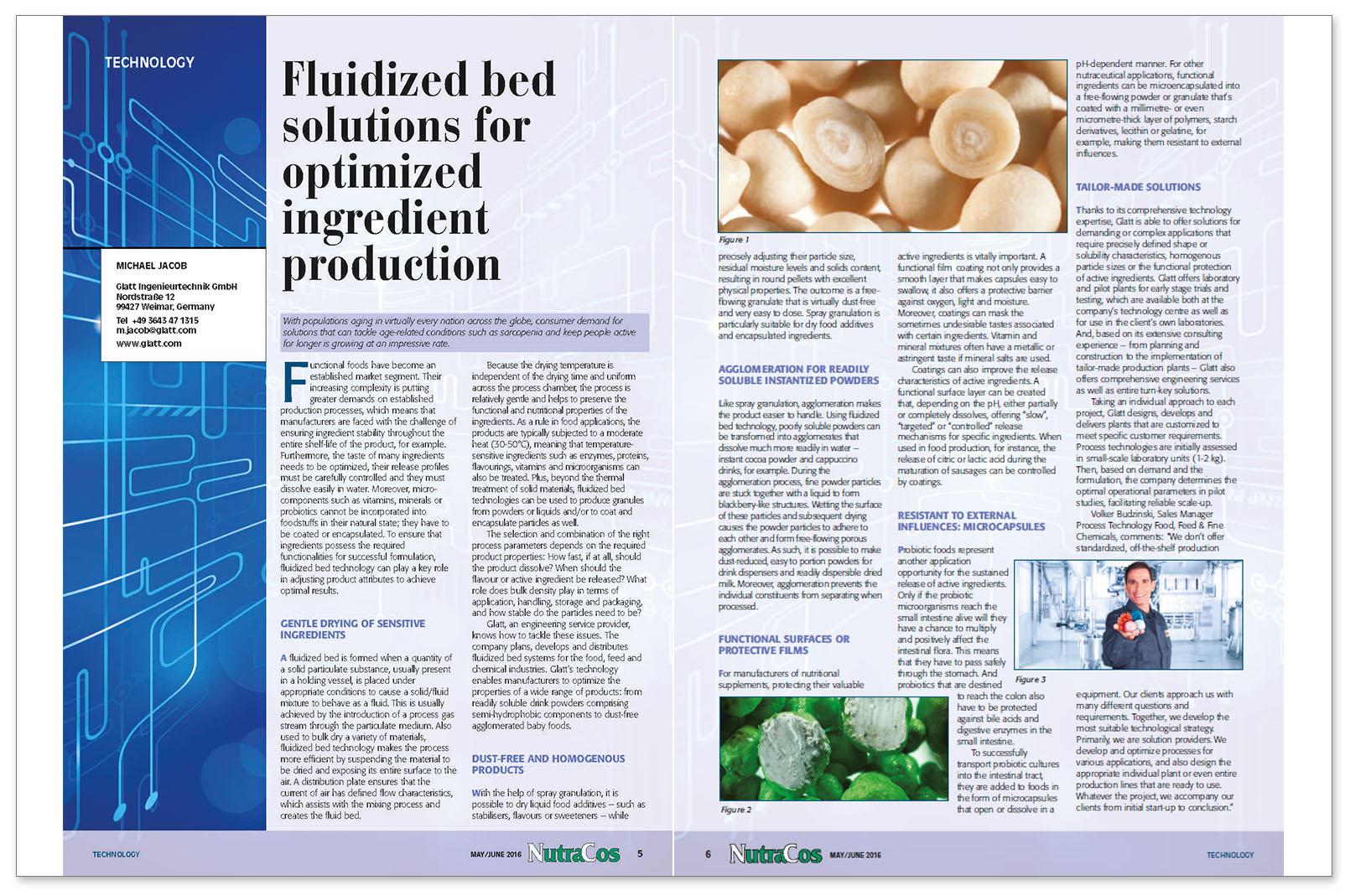
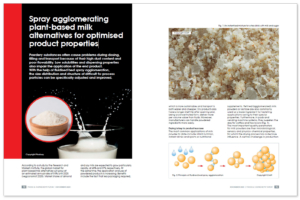
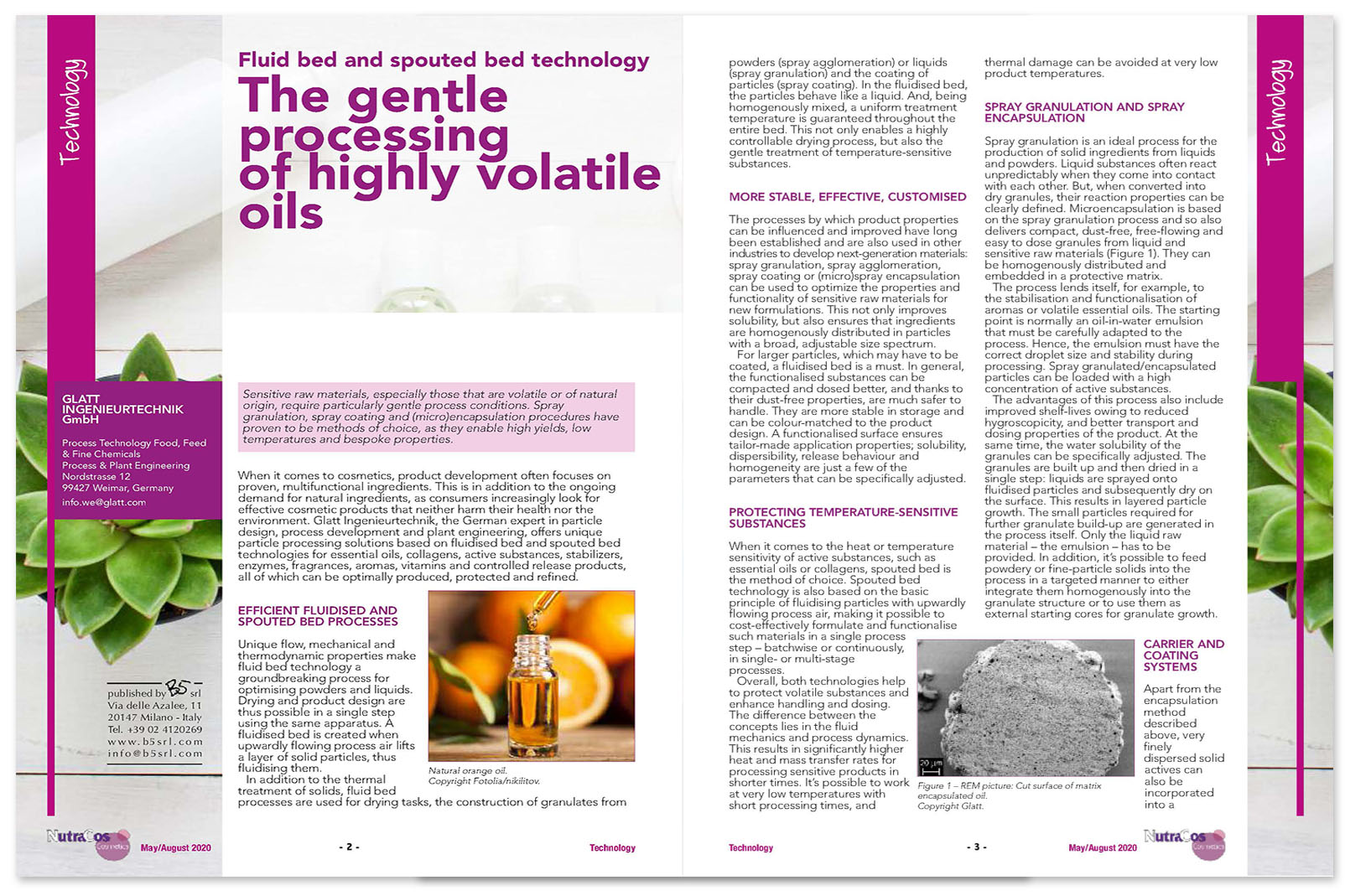
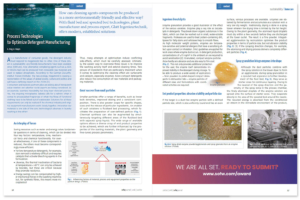
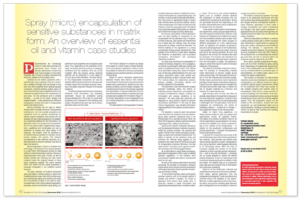
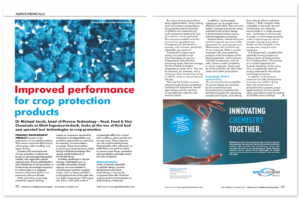
 Copyright: Johnson-Johnsen Publishing
Copyright: Johnson-Johnsen Publishing